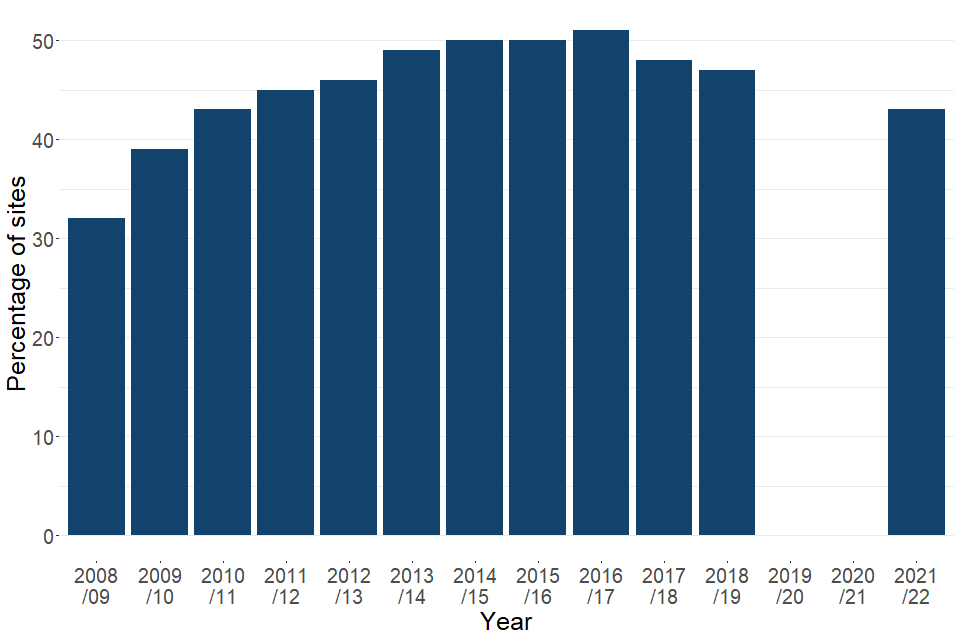16 Integrating biodiversity considerations into local decision making
Updated 3 April 2024
Applies to England
Data last updated: November 2023
Latest data available: 2021/22
Introduction
This indicator shows the proportion of the total number of Local Sites in England where positive conservation management is being implemented or has been implemented in the last 5 years.
Local Sites are sites designated locally for their substantive nature conservation importance, either for wildlife or geology. Sites in positive conservation management are defined as those sites which are being managed in order to conserve their nature conservation interest. Assessing the extent of positive management can help to identify sites where positive management is lacking and will help to focus the efforts of Local Site Partnerships in ensuring Local Sites are managed and their nature conservation value is maintained or enhanced.
This is the first publication of these data since May 2021, when data relating to 2018/19 was first published. To reduce the burden on Local Authorities during the COVID-19 pandemic, Defra did not request data in 2020 or 2021 resulting in a gap in the time series.
Type of indicator
Response indicator
Assessment of Change
- Long term (2008/09 to 2021/22): Improving
- Short term (2016/17 to 2021/22): Deteriorating
- Latest year (2020/21 to 2021/22): cannot assess latest year change
Note: The long-term and short-term assessment of these measures is based on a 3% rule of thumb. The base years for these assessments use a 3-year average, see Assessing Indicators.
Local Sites under positive conservation management
Trend description for Figure 16.1
In the 5 years prior to 31st March 2022, 43.155% of Local Sites across England for which we received data, were in positive conservation management. This is an increase of 11.465 percentage points since 2008/09 when data were first collected, and a drop of 4 percentage points since 2018/19 when the data were last collected (Figure 16.1).
Figure 16.1: Proportion of Local Sites in England under positive conservation management, 2008/09 to 2021/22

Download the data for Figure 16.1 in ods format
Notes about Figure 16.1
- Each bar represents the percentage of local sites in positive conservation management for the 5 years prior to 31st March of that year.
- The total number of responding local authorities and number of sites varies between years. In 2021/22, 69 (46%) local authorities were included in the analysis.
- No data were requested from local authorities in 2019/20 and 2020/21 due to the anticipated resourcing issues resulting from complying with COVID-19 restrictions.
Further information
Relevance
The indicator is relevant to outcome 1 in Biodiversity 2020: A strategy for England’s wildlife and ecosystem services (see Annex A). It is also relevant to strategy priority action 2.2:
Promote taking better account of the values of biodiversity in public and private sector decision-making, including by providing tools to help consider a wider range of ecosystem services.
The indicator is relevant to international goals and targets (see Annex B of Biodiversity 2020: A strategy for England’s wildlife and ecosystem services).
The UK and England Biodiversity Indicators are currently being assessed alongside the Environment Improvement Plan Targets, and the new Kunming-Montreal Global Biodiveristy Framework Targets, when this work has been completed the references to Biodiversity 2020 and the Aichi Global Biodiversity Framework Targets will be updated.
Background
Local Sites are non-statutory areas designated at local level for their significant nature conservation value. They include both local wildlife sites (designated for significant biodiversity value) and local geological sites (designated for their significant geological value). Local Site systems are operated at a local level, with local authorities working with Local Sites Partnerships made up of key stakeholders.
According to The state of England’s Local Wildlife Sites 2018, there are estimated to be more than 40,000 Local Sites in England, covering contrasting landscapes in coastal, rural and urban situations. Although they do not have any statutory status, many are equal in quality to the representative sample of sites that make up the series of statutory Sites of Special Scientific Interest (SSSIs). They are an important component of England’s ecological network and have an important role to play in meeting our national biodiversity objectives.
There are currently a number of different terms in use locally to describe these sites, including Sites of Importance for Nature Conservation (SINCs), Sites of Nature Conservation Importance (SNCIs) and Regionally Important Geological Sites (RIGS). Defra uses the common term Local Site.
Defra published guidance on the identification, selection and management of Local Sites in 2006.
These data are from local authority single data list 160-00 on local nature conservation/biodiversity.
The data for 2010/11 to 2018/19, and 2021/22 were collected by Defra from unitary and higher tier local authorities. Data for 2008/09 and 2009/10 were previously published by the Department for Communities and Local Government.
In 2021/22, 46% of local authorities submitted data on Local Sites, compared with 58% in 2018/19 when data were last collected. A total of 69 local authorities were included in the analysis in 2021/22 and 80 local authorities were excluded due to not providing data for 3 consecutive years (noting that Defra did not request data in 2019/20 or 2020/21). No imputation for missing data was done this year due to the gap in data collection.
